 OK, my busiest time of the month is finally over and now I have time to write about the Japanese sauces I have in my kitchen, as requested by one of dear readers about two weeks ago. I don’t know if this is going to be helpful for anyone, but some people might, at least, find this interesting. Honestly I learned a lot from doing this, and I really thank Sara for bringing up this idea. OK, my busiest time of the month is finally over and now I have time to write about the Japanese sauces I have in my kitchen, as requested by one of dear readers about two weeks ago. I don’t know if this is going to be helpful for anyone, but some people might, at least, find this interesting. Honestly I learned a lot from doing this, and I really thank Sara for bringing up this idea.
In this post, the ones with photos are the ones I actually have in my kitchen now. I also wrote about some popular variations, and tried to include some trivia that even Japanese people may not have heard of. Of course I’m no expert, so corrections and feedbacks from readers are highly appreciated! :) And I hope you enjoy this as much as I did.
* For each entry, in front of the explanations, I put 1) possible product name in English, 2) its Japanese name spelled with the alphabet, 3) with Chinese characters, and 4) with hiragana (Japanese syllabary).
* Information included in this post may not apply to the similar products sold outside Japan.
Read More
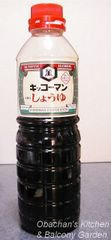 Dark soy sauce, koikuchi shoyu 濃口醤油 こいくちしょうゆ: (See photo.) Real basic and versatile liquid seasoning made from soybeans. When a Japanese recipe calls for “soy sauce (shoyu, 醤油 しょうゆ),” it usually means this type of soy sauce, unless the recipe specifically mentions other types of shoyu. Dark soy sauce, koikuchi shoyu 濃口醤油 こいくちしょうゆ: (See photo.) Real basic and versatile liquid seasoning made from soybeans. When a Japanese recipe calls for “soy sauce (shoyu, 醤油 しょうゆ),” it usually means this type of soy sauce, unless the recipe specifically mentions other types of shoyu.
Light soy sauce, usukuchi shoyu 薄口醤油 うすくちしょうゆ: Used for simmered/steamed dishes that shouldn’t be colored too brown with the sauce. Though the color is lighter, its salt-content is higher than dark soy sauce. To make the saltiness milder, amazake (non-alcoholic? drink made from fermented rice) is added. More commonly used in Kansai area than in Kanto. They say the difference can be observed by comparing the color of noodle soup; Kanto-style noodle soup is much darker than Kansai-style soup.
Tamari soy sauce, tamari shoyu 溜醤油 たまりしょうゆ: Very dark, thick soy sauce used as dipping sauce for sashimi and sushi.
White soy sauce, shiro shoyu 白醤油 しろしょうゆ: Amber colored sauce mainly made from wheat. Contains more sugar than soy sauces made from soybeans. Not sterilized by heating, thus contains live yeast and expires faster than other kinds of soy sauces. Used for simmered/steamed dishes that shouldn’t be colored brown with the sauce.
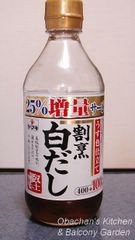 Concentrated dashi seasoning, shiradashi/shirodashi 白だし しらだし/しろだし: White soy sauce or light soy sauce blended with various kinds of dashi stock. The stock is mainly made from dried bonito flakes, kelp and dried black mushrooms. Can be used as the substitute for light soy sauce. (That's why I don't buy light soy sauce any more and buy this instead.) Concentrated dashi seasoning, shiradashi/shirodashi 白だし しらだし/しろだし: White soy sauce or light soy sauce blended with various kinds of dashi stock. The stock is mainly made from dried bonito flakes, kelp and dried black mushrooms. Can be used as the substitute for light soy sauce. (That's why I don't buy light soy sauce any more and buy this instead.)
 Dashi powder, hunmatsu dashi, 粉末だし ふんまつだし: I was really tempted to call this Hondashi ほんだし, but it’s a product name by a particular brand, like calling a photocopy machine “Xerox,” so I used a name that sounds more "generic" above. Anyway, I've found many miso-soup recipes written in English telling you to make dashi stock from dried bonito flakes and/or kelp. That’s a traditional, formal way, and probably the best way, but do you really think that we do that every morning?! Especially those busy housewives who have to cook breakfast and pack lunch for husbands and kids, and then go out for a part-time work? No way. Dashi powder, hunmatsu dashi, 粉末だし ふんまつだし: I was really tempted to call this Hondashi ほんだし, but it’s a product name by a particular brand, like calling a photocopy machine “Xerox,” so I used a name that sounds more "generic" above. Anyway, I've found many miso-soup recipes written in English telling you to make dashi stock from dried bonito flakes and/or kelp. That’s a traditional, formal way, and probably the best way, but do you really think that we do that every morning?! Especially those busy housewives who have to cook breakfast and pack lunch for husbands and kids, and then go out for a part-time work? No way.
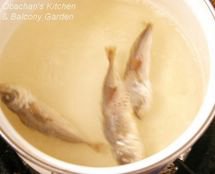 Using bonito flakes for making dashi is not only time consuming but an expensive luxury! Can you imagine how much you have to use for one time… and how much garbage that’ll make? So proudly, we --- at least my family members and relatives --- depend on this type of dashi powder for everyday meals, and I’m sure a lot of Japanese families are like us. (When I want some extra dashi flavor for my miso-soup, I throw in some dried baby fish in addition to dashi powder and take them out before adding other ingredients to the soup.) Using bonito flakes for making dashi is not only time consuming but an expensive luxury! Can you imagine how much you have to use for one time… and how much garbage that’ll make? So proudly, we --- at least my family members and relatives --- depend on this type of dashi powder for everyday meals, and I’m sure a lot of Japanese families are like us. (When I want some extra dashi flavor for my miso-soup, I throw in some dried baby fish in addition to dashi powder and take them out before adding other ingredients to the soup.)
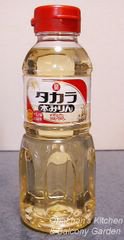 Rice Wine, mirin 味醂 みりん: Made from glutinous rice, malted rice and shochu (distilled spirit). Contains apx. 13 – 14% alcohol (thus, alcohol tax applied in Japan) and apx. 40% sugar and its color is similar to vinegar. Widely used for things like simmered food, teriyaki, soups, dressings, sweets, etc. Essential for giving sweetness and glossy sheen to teriyaki-type of dish. Various amino-acids and succinic acid contained add extra flavor, and the alcohol helps the food absorb the flavor of seasonings. When the taste of alcohol is not desired, should be boiled briefly beforehand to let alcohol evaporate. Often called hon-mirin (本味醂 ほんみりん) to distinguish from mirin-like seasoning mentioned below. Rice Wine, mirin 味醂 みりん: Made from glutinous rice, malted rice and shochu (distilled spirit). Contains apx. 13 – 14% alcohol (thus, alcohol tax applied in Japan) and apx. 40% sugar and its color is similar to vinegar. Widely used for things like simmered food, teriyaki, soups, dressings, sweets, etc. Essential for giving sweetness and glossy sheen to teriyaki-type of dish. Various amino-acids and succinic acid contained add extra flavor, and the alcohol helps the food absorb the flavor of seasonings. When the taste of alcohol is not desired, should be boiled briefly beforehand to let alcohol evaporate. Often called hon-mirin (本味醂 ほんみりん) to distinguish from mirin-like seasoning mentioned below.
Mirin-like liquid seasoning, mirin-huu chomiryo みりん風調味料 みりんふう ちょうみりょう: Made by adding glutamic acid and other seasonings to thinned syrup (glucose sugar or starch syrup). Its alcohol content is less than 1%, and sugar content is higher than mirin. Not necessary to boil before using.
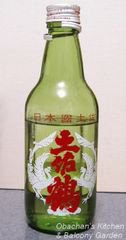 Sake, sake 酒 さけ: Now this is something I do but many Japanese housewives may not: I use drinking sake for cooking, not cooking sake (ryori-yo sake 料理用酒). It doesn’t have to be this brand in the photo, but it HAS TO be drinking sake. For me it makes a BIG difference in taste. Sake, sake 酒 さけ: Now this is something I do but many Japanese housewives may not: I use drinking sake for cooking, not cooking sake (ryori-yo sake 料理用酒). It doesn’t have to be this brand in the photo, but it HAS TO be drinking sake. For me it makes a BIG difference in taste.
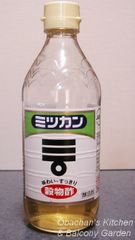 Vinegar, su 酢 す: Usually refers to the kind of vinegar made from several kinds of grains such as wheat, rice and corn. More precisely, this type is classified as grain vinegar, kokumotsu su 穀物酢 こくもつす. Most regular and inexpensive kind. Vinegar, su 酢 す: Usually refers to the kind of vinegar made from several kinds of grains such as wheat, rice and corn. More precisely, this type is classified as grain vinegar, kokumotsu su 穀物酢 こくもつす. Most regular and inexpensive kind.
Rice vinegar, komezu 米酢 こめず: Vinegar made from rice. A little milder and deeper flavor of this vinegar is said to be most suitable for Japanese traditional vinegared dishes, but this is a little more expensive than grain vinegar.
Sushi vinegar, sushizu すし酢 すしず: Grain vinegar with sugar, salt and dashi-seasonings added. Basic ingredients necessary for seasoning sushi rice are already included, so you can make sushi rice by mixing this vinegar alone to warm rice (but I prefer mixing sushi vinegar my own way).
Ponzu sauce, Ponzu ぽん酢 ぽんず: A sauce made by mixing ingredients including citrus juice, mirin, dashi-stock, soy sauce, and vinegar. The name came from a Dutch word, “pons” which means citrus (juice).
 Yuzu-mixed Ponzu, yuzu-pon ゆずぽん: Ponzu with extra yuzu flavor. I have to have this when I eat nabe (Japanese hotpot dish). Yuzu-mixed Ponzu, yuzu-pon ゆずぽん: Ponzu with extra yuzu flavor. I have to have this when I eat nabe (Japanese hotpot dish).
Worcestershire sauce, usuta- sosu, ウスターソース: If you eat at a casual eatery in Japan and see a small container on the table with a label saying simply “ソース(sauce),” it’s almost always Worcestershire sauce.
 Tonkatsu sauce, tonkatsu sosu, とんかつソース: Thicker and sweeter sauce made by adding a lot more fruits/vegetables than Worcestershire sauce. Good with cutlets, okonomi-yaki お好み焼き (Japanese savory pancakes) and takoyaki た こ焼き (octopus balls). There are sauces specifically named “okonomi-yaki sauce” お好み焼きソース and "takoyaki sauce" たこ焼きソース, too, but they are basically not too different from tonkatsu sauce, I think …just some difference in flavor, sweetness and/or thickness. Tonkatsu sauce, tonkatsu sosu, とんかつソース: Thicker and sweeter sauce made by adding a lot more fruits/vegetables than Worcestershire sauce. Good with cutlets, okonomi-yaki お好み焼き (Japanese savory pancakes) and takoyaki た こ焼き (octopus balls). There are sauces specifically named “okonomi-yaki sauce” お好み焼きソース and "takoyaki sauce" たこ焼きソース, too, but they are basically not too different from tonkatsu sauce, I think …just some difference in flavor, sweetness and/or thickness.
-----
Well, this should be enough for part I. While working on this write-up, I thought, “Oh, maybe I can write about sugar, miso, flour and cooking oil, too!!” So there probably will be part II someday in the near future, unless you find this type of entry distasteful and tell me not to post any more ;)
Categories: Seasonings
|
![]()

![]()
28 comments:
Hey Ob's! Quick question for ya, I have a "my blogging girlfriends" listing in my left hand sidebar on my site, and I wanted to add you! :)
If that is ok, shoot me an email. All I need your 'okay' on is to use an image from your site to use as a link to your site. (See my sidebar for examples)
Let me know when you have a sec. :D
somethingsoclever@hotmail.com
Oh, I almost forgot,
Just a quick note to let you know that the link you have for Something So Clever has changed! It is now http://somethingsoclever.typepad.com
*Just a friendly reminder* :D
I just wish Japanese food companies would also include an English translation of their products. Here in the Philippines I would look at a whole array of Japanese ingredients but I can't figure out what they are unless the grocery store labels them in English.
Obachan,
Thanks so much for this post. I've been in Japan for about 3 months now, and while I was a keen cook back in England, I've found it difficult to get to grips with the basics of Japanese cooking - especially the Kanji! This was a real help.
Obachan, darling. This is a great post. I learned so much, and I haven't even digested most of it.
I'm so pleased to learn your opinion on traditional dashi. I've always thought it was so wasteful.
xxx!
cc
Hi, I found this a very useful entry! Definitely something I'll keep in mind next time I buy Japanese sauces...that yuzu-pon sounds pretty interesting.
Just a question, for the dashi stock powder, does it contain alot of MSG? It doesn't seem very healthy to have so much MSG everyday...
really informative. thanks
ThAAniya
Thanks for your nice comment. Maybe I’ve said this many times before, but it’s so encouraging to hear that someone enjoys reading my posts. It’s still kind of unbelievable…
Alicat
Hey, I saw that you chose my carrot cake photo. Thanks! :D
Maricel
Until I read your comment, I had thought that they’d put English labels on their products to be sold outside Japan, but sounds like that’s not the case? Mmmm… I wonder what’s keeping them from doing so.
Jamie
I just hope that my post doesn’t give you a wrong information and put you in trouble at a supermarket or in your kitchen ;)
cookiecrumb
Oh it’s so nice of you. I really love the taste of our traditional dashi, but it’s just the amount of bonito flakes that you have to throw away, you know. If it’s kelp, you can chop it up and mix into other simmered food or soup and eat it up, but bonito flakes….
evangeline
Hi. So glad to hear that you think this entry is useful :) What I wrote here may not apply to the Japanese sauces sold in your country, though.
About MSG, I have no idea exactly how much MSG the dashi stock powder contains…I just hope it’s not much. Actually, I don’t use ajinomoto at home, but I do use this dashi powder, thinking that being mixed with other ingredients like ground bonito and kelp, the MSG content should be much lower than ajinomoto. I don’t make miso soup every day, so I use dashi powder maybe 3 or 4 times a week. Hope it’s not often enough to cause a health problem.
I’m inclined to think that just a small amount of MSG is not an immediate threat to health…because, I assume, it’s difficult to live a totally MSG-free life in Japan these days anyway. That seasoning is probably added to most of the store-bought seasonings and sauces.
rokh
Thanks for dropping by :) I'm happy if this entry was useful to you in any way.
thank you for your helpful explanations!
Hi Obachan,
I am curious about the content of Mirin after reading your post. My family had been using it in cooking, sometimes as a substitute for Chinese rice wine, without knowing that the alcohol content in it is the same as shochu. What I am curious is whether the shochu in mirin is really the same as the shochu one can buy from sakeya. Occasionally my family would have shochu to go with sukiyaki and shabu shabu during festive dinner.
CJ’s Food & Discovery
Hi
I’d be happy if what I wrote here was useful rather than confusing. I did my best in doing some research on the net, but I’m no expert and I might have misunderstood what I read, so please keep that in mind… ;P
tiptup
Thank you for visiting and leaving a kind comment :)
kelken
Hi
Thanks for your question. According to the Japanese websites I went through, shochu is used as an ingredient to make mirin, but the percentage of alcohol is much lower in mirin. Honestly, I don’t know what kind of shochu is actually used to make mirin. Shochu seems to be officially classified into 2 categories according to the difference in distilling method(??) AND the percentage of alcohol contained, and there are many variations depending on what they are made from. I have no idea if there’s any rule like “this kind of shochu should be used for making mirin, but not that kind.” My hunch is that drinking shochu is probably of higher quality than the one that is used as an ingredient for making something else, but who knows… some brand might be using top quality shochu to make top quality mirin…
I guess using shochu for cooking is nothing strange here in Japan, too, but adding shochu wouldn’t give exactly the same result as adding mirin and vice versa.
Sorry I cannot answer your question any better.
Hi Obachan,
Thanks for shedding some light on this. Even though I am Japanese (American-born), there are a few types of sauces shown here that I am unfamiliar with. I think I need to study Japanese cooking more.
Hi Obachan,
I LOVE your food blog. It makes me hungry and you give me complete inspiration to cook more healthier for myself and my family. Thank you.
I am half Japanese living in Guam and I am presently new to blogging.
Hi, Obachan,
I was looking for liquid dashi concentrate the last time I went to the Asian market and they didn't know what I was talking about and I can't read Japanese to find it by myself. Next time I'll be armed with the proper name, shiradashi, and maybe I'll be able to get it. Thank you!
obachan, I also use the powdered dashi as they are the easiest. Love the explainations and yes, I do agree that drinking sake is so much better than cooking sake. I'm guilty of using drinking sake too for my Japanese cooking.
Hi Obachan,
Thanks a lot for your explanation! It was very helpful! I did not mean to imply that adding shochu is a strange practice, on the contrary my family has been using various kinds of wine in cooking. I do agree that shochu adds a very distinct flavour and fragrance to the food. What I find amusing has to do with a story from long time ago. At that time my sister was on a mad search for shochu in the local major liquor stores but was puzzled by the fact that none of them carry it (I did not ask her how she got to know about it). She was dying to buy it, and so during one of my stopover in Kyoto before returning home for Christmas, I was assigned the mission to buy 'a few' bottles (you can tell how desperate she was because she did not specify a lower limit and basically instructed me to buy 'as many bottle as convenient'). The problem is, I think, shochu is not as popular as sake in the commercial liquor stores. So I actually had to spend a conscious effort in searching for it. And when I eventually landed in a store which specialises in local Japanese liquor, I was awestruck. I immediately realised that it was not just a matter of grabbing a bottle from the shelf, because there was a huge variety of them. I could still remember vividly the sorry look on the face of the staff at the counter when I asked her which label was good. She jovially told me that every bottle was good, and I really felt like buying the whole store down. She was very kind to let me sample countless bottles of them made from various ingredients and by various breweries. By the god-knows-how-many bottle, I had already lost my sense of taste. Eventually, I settled down on one imojochu and one komejochu. The joke is we did not even realise that there was actually shochu in the mirin we used!
What a fantastic reference, Obachan.
I didn't know that the "pon" in ponzu came from a Dutch word. Is that the same "pon" as dekopon, ponkan etc? I've always wondered where those odd citrus names came from.
And one more question- which seasonings do you keep in the fridge?
Reid
Even though I am Japanese (Japanese-born), most of the things I wrote in this entry were new findings to me, honestly. :)
Jeanette
Hi. Thanks for visiting my blog. :D So happy to hear that you think my site is inspirational, but I doubt if it can be associated with “cooking healthy.” I guess the emphasis is more on “taking an easy way out” and “satisfying my curiosity…” ;P
Sara
Thank YOU for giving me the idea. I really hope this entry does not give you a wrong information. Please be careful because the information here may not apply to the products you find over there.
Annie
Hi. Happy to be of help. They might call it “shirodashi” instead of “shiradashi” in the U.S. Anyway, I hope you can get it over there. Good luck!
boo_licious
Glad to find another person who likes using drinking sake for cooking. : ) What we do at my parents’ house is that after Buddhist ceremonies and big feasts, if we find sake left in the bottles on the tables, we empty it in a big bottle and use it for cooking. We feel less guilty when using this kind of sake.
kelken
Oh, no, I didn’t think you implied that using shochu for cooking was a strange practice. And sorry, I laughed so much after reading your comment…picturing you in a liquor store surrounded by all kinds of shochu and tasting them one by one! :D Hope your sister enjoyed the shochu you brought back.
Amy
Good guess, but “pon” in ponkan did not come from the Dutch word. I just found about it on this site: they say it came from “Poona,” a place in India where the orange originated from. (Though my dad grows ponkan oranges, I didn’t know this until this minute.)
Among the sauces included in this entry, Shirodashi and Yuzupon are the ones kept in my fridge right now. In summer, I put vinegar and tonkatsu sauce in the fridge, too. But this might be a strange practice ;)
thanks obachan,
loved going through this blog and am going to enjoy my next grocery expedition. :)
Good luck and have fun! And be careful with my entries... usually I find mistakes after posting and correct them over and over (I just found a big mistake in my another blog and felt really embarrassed yesterday), so it may be safe to wait for a few weeks before you actually use this entry for your reference. ;P
Hi crazy gaijin,
(I don’t really like calling non-Japanese people “gaijin,” though.)
ようこそ!You have wonderful blogs, too. Especially the glossary of Japanese cooking terms will help me a great deal when I write about Japanese cooking. And I'm sure I'm not the only one benefitting from that site. どうもありがとうございます。
My acquisition of English language still has a LONG way to go, too. お互いがんばりましょう。(←Japanese people's favorite phrase ne?) ;)
Hi Obachan,
I'm catching up on my blog reading, so I'm only reading this entry now. It's a great reference; I've got most of these things in my kitchen too, albeit with different labels (the koikuchi shoyu I use is in exactly the same bottle, though). I think I've seen that yuzu-pon bottle at the Asian supermarket, too, hmm. :)
I have to cook with cooking sake because I'll drink drinking sake. If I have some drinking sake on hand when I'm cooking something that calls for sake, however, I use it then, and there is a difference in the taste. I do find that the cooking sake is better than most other cooking wines I've used (and mostly don't use any more); it's not as salty.
About how much dashi powder do you use when making dashi? I usually make dashi with bonito flakes (you're right, it does create a big pile of soggy leftovers) but I'm not sure about the proportions used when using the powder to make dashi.
Whenever I walk into the Asian supermarket, I'm always overwhelmed by the variety of bases for noodle sauces or soups. I like to make my own sauces, but I always wonder what I'm missing...
Hi Winslow,
About the dashi powder,
The package says: Use 4g of powder to make 600 mL of dashi stock or miso soup or clear soup. (Sorry, please do the conversion.) But I think I usually use less than that.
It also says: Add half of the required amount in the beginning of cooking, and add the rest when it’s almost ready.(Mmmmm.. I didn't know this.)
About sake,
After the brewery tour, I cannot use high-grade sake (ginjo-shu or above) for cooking any more (even if it was a gift from someone) because now I know how it is made. But I’ll keep using regular drinking sake for cooking. ;)
Hi Obachan,
Thankfully, my measuring cup has "regular" (i.e., cups) measurements on one side and metric on the other side. Plus my dashi powder envelopes are 10 grams each, so that means a little less than half each envelope. I'm sure there's an internet converter I could use, but if I can figure it out by myself in the kitchen, so much the better!
I want that kind of measuring cup, too.
Hi Obachan,
Thank you very much for this post...the pictures were the most helpful as it's difficult to choose between brands in the shops! I consider them your own personal recommendation!
Su-Lin
Hi Su-Lin,
Thanks for your comment, but NO!!! I don’t mean to particularly recommend any of them over others. I bought most of them just because they were on sale that day; if other brands were on sale, I would have gone for them. And if I were rich, I would choose organic ones for some of the sauces.
Dear Obachan,
You say you don't like calling non-Japanese gaijin, but I don't like calling women obachan either. Maybe because I'm just about to reach that age...
I did hear something once that dashi powder has MSG in it. Of course, the MSG debate is long and complicated by the fact that it has basically the same chemical structure as that current fad in international cuisine called Umami.
I use a kind of dashi that is basically bonito flakes in little tea bags. They're so easy to use and I think they're organic. I doubt, however, that they're readily available in international Asian markets. Have you tried them?
Best,
Hanna
Post a Comment